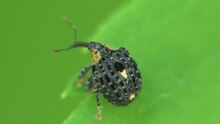Curculionidae
| True weevils and bark beetles | |
|---|---|
 | |
Bantiades rectalis | |
Scientific classification | |
| Kingdom: | Animalia |
| Phylum: | Arthropoda |
| Class: | Insecta |
| Order: | Coleoptera |
| Suborder: | Polyphaga |
| Infraorder: | Cucujiformia |
| Superfamily: | Curculionoidea |
| Family: | Curculionidae Latreille, 1802 |
Diversity | |
Some 20 subfamilies (but see text) | |

Dissostomus hornabrooki

A true weevil
The Curculionidae are the family of the "true" weevils (or "snout beetles"). They are one of the largest animal families, with 6,800 genera and 83,000[1] species described worldwide.
They include the bark beetles as subfamily Scolytinae, which are modified[unreliable source?] in shape in accordance with their wood-boring lifestyle. They do not much resemble other weevils, so they were traditionally considered a distinct family, Scolytidae. The family also includes the ambrosia beetles, of which the present-day subfamily Platypodinae was formerly considered the distinct family Platypodidae.
Contents
1 Description
2 Phylogeny and systematics
3 See also
4 References
5 External links
Description
They are recognized by their distinctive long snouts and geniculate antennae with small clubs; beyond that, curculionids have considerable diversity of form and size, with adult lengths ranging from 1 to 40 mm (0.04 to 1.57 in).

Curculio elephas
Weevils are almost entirely plant feeders, and most species are associated with a narrow range of hosts, in many cases only living on a single species. With so many species to classify and over 400 genera, the taxonomy of this family is quite complicated, and authors disagree on the number and placement of various subfamilies, tribes, and subtribes.
Phylogeny and systematics
The phylogeny of the group is complex; with so many species, a spirited debate exists about the relationships between subfamilies and genera. A 1997 analysis attempted to construct a phylogeny based mainly on larval characteristics.[2]
Recent work on the phylogenetic relationships in weevils mentions the two subfamily groups Adelognatha (short-nosed weevils, subfamily Entiminae) and Phanerognatha (long-nosed weevils, subfamilies of Curculionidae other than Entiminae) for the species of Curculionidae.[3]
Almost two dozen subfamilies are recognized by some authors even when merging those that are certainly invalid. Others, however, recognize a lesser number – the only subfamilies that are almost universally considered valid are the Baridinae, Cossoninae, Curculioninae, Cyclominae, Entiminae, Molytinae, Platypodinae, and Scolytinae. The various proposed taxonomic schemes typically recognize as many additional subfamilies again, but little agreement is seen between authorities about which. In particular, the delimitation of the Molytinae has proven difficult.

Bantiades rectalis
The subfamilies considered valid by at least some authors today:
Bagoinae (sometimes in Molytinae)- Baridinae
Brachycerinae (disputed)
Conoderinae (sometimes in Baridinae)- Cossoninae
Cryptorhynchinae (sometimes in Curculioninae)
 Play media
Play media
Cionus tuberculosus (Curculioninae)
- Acalles
Curculioninae – flower weevils, acorn and nut weevils- Cyclominae
Dryophthorinae (disputed)
Entiminae – broad-nosed weevils
Hyperinae (sometimes in Molytinae)
Lixinae (sometimes in Molytinae)
Mesoptiliinae (sometimes in Molytinae)- Molytinae
Orobitidinae (sometimes in Baridinae)
Platypodinae – typical ambrosia beetles
Raymondionyminae (sometimes in Brachycerinae)
Scolytinae – bark beetles
Xiphaspidinae (sometimes in Baridinae)
See also
- Black vine weevil
- Boll weevil
- Pecan weevil
- Wheat weevil
- Hylobius
- Scolytoplatypus
- Pests and diseases of roses
References
^ "Curculionidae". www.gbif.org..mw-parser-output cite.citation{font-style:inherit}.mw-parser-output q{quotes:"""""""'""'"}.mw-parser-output code.cs1-code{color:inherit;background:inherit;border:inherit;padding:inherit}.mw-parser-output .cs1-lock-free a{background:url("//upload.wikimedia.org/wikipedia/commons/thumb/6/65/Lock-green.svg/9px-Lock-green.svg.png")no-repeat;background-position:right .1em center}.mw-parser-output .cs1-lock-limited a,.mw-parser-output .cs1-lock-registration a{background:url("//upload.wikimedia.org/wikipedia/commons/thumb/d/d6/Lock-gray-alt-2.svg/9px-Lock-gray-alt-2.svg.png")no-repeat;background-position:right .1em center}.mw-parser-output .cs1-lock-subscription a{background:url("//upload.wikimedia.org/wikipedia/commons/thumb/a/aa/Lock-red-alt-2.svg/9px-Lock-red-alt-2.svg.png")no-repeat;background-position:right .1em center}.mw-parser-output .cs1-subscription,.mw-parser-output .cs1-registration{color:#555}.mw-parser-output .cs1-subscription span,.mw-parser-output .cs1-registration span{border-bottom:1px dotted;cursor:help}.mw-parser-output .cs1-hidden-error{display:none;font-size:100%}.mw-parser-output .cs1-visible-error{font-size:100%}.mw-parser-output .cs1-subscription,.mw-parser-output .cs1-registration,.mw-parser-output .cs1-format{font-size:95%}.mw-parser-output .cs1-kern-left,.mw-parser-output .cs1-kern-wl-left{padding-left:0.2em}.mw-parser-output .cs1-kern-right,.mw-parser-output .cs1-kern-wl-right{padding-right:0.2em}
^ Adriana E. Marvaldi (1997). "Higher level phylogeny of Curculionidae (Coleoptera: Curculionoidea) based mainly on larval characters, with special reference to broad-nosed weevils" (PDF). Cladistics. 13 (4): 285–312. doi:10.1111/j.1096-0031.1997.tb00321.x.
^ François Lieutier, Keith R. Day, Andrea Battisti, Jean-Claude Grégoire, and Hugh F. Evans, Bark and Wood Boring Insects in Living Trees in Europe, a Synthesis. Springer Science & Business Media, 2004
External links
 Media related to Curculionidae at Wikimedia Commons
Media related to Curculionidae at Wikimedia Commons
 Data related to Curculionidae at Wikispecies
Data related to Curculionidae at Wikispecies- Images of Curculionidae species found in New Zealand
On the University of Florida / Institute of Food and Agricultural Sciences Featured Creatures website:
Anthonomus eugenii, pepper weevil
Cylas formicarius, sweetpotato weevil
Chalcodermus aeneus, cowpea curculio
Cosmopolites sordidus, banana root borer
Eudociminus mannerheimii, cypress weevil- Eurhinus magnificus
Gerstaeckeria spp.
Metamasius callizona, Mexican bromeliad weevil
Metamasius hemipterus sericeus, silky cane weevil,
Metamasius mosieri, Florida bromeliad weevil
Naupactus (=Graphognathus) spp., whitefringed beetles
Oxyops vitiosa, melaleuca weevil
Pantomorus cervinus, Fuller rose weevil
Pseudocneorhinus bifasciatus, twobanded Japanese weevil
Rhynchophorus cruentatus, palmetto weevil
Sphenophorus venatus, hunting billbug
Other University web pages on economically important curculids:
Conotrachelus nenuphar, plum curculio from the Ohio State University
Orchestes pallicornis, apple flea weevil from Michigan State University
